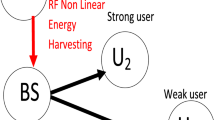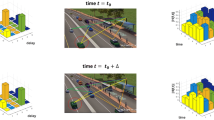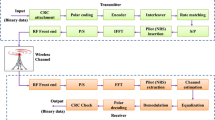Abstract
The \({\kappa -\mu /}\)Inverse Gamma (KMIG) and \({\eta -\mu /}\)Inverse Gamma (EMIG) are recently introduced composite fading distributions for the precise design of the wireless systems, where multipath fading and shadowing occur concomitantly. Further, these composite fading models are competent to be employed in the performance investigation of the digital communication system as their mathematical formulations are quite tractable. Average symbol error probability (SEP) and channel capacity analysis are important parameters to investigate the performance of a digital communication system. The applicability of these fading models is illustrated by analysing the performance matrices of the digital communication channels in the present work. Various performance matrices such as the average SEP, the channel capacity under different adaptive schemes namely, optimum rate adaptation (ORA), channel inversion with fixed rate (CIFR) and truncated CIFR are derived. The asymptotic analysis of KMIG and EMIG composite fading models over average SEP performance matrices with coding gain and diversity gain is also carried out in this work. The simplified high and low signal-to-noise-ratio solutions to channel capacity are also provided as a by-product. In addition, approximate analysis to ORA and CIFR capacity are provided under realistic environmental conditions. The accuracy of the derived numerical formulations is validated with the use of Monte–Carlo simulation. The results of present work will be advantageous in the modelling and designing of popular wireless services such as vehicle-to-vehicle communication, wearable communication and wireless power transfer related technologies.









Similar content being viewed by others
References
Dong, Y., & Fan, P. (2013). Bounds on the average transmission rate in high speed railway wireless communications.International Workshop on High Mobility Wireless Communications (HMWC), Shanghai (pp. 142–145).
Nezami, Z., & Zamanifar, K. (2019). Internet of things\(/\)Internet of everything: Structure and ingredients. IEEE Potentials, 38(2), 12–17.
Costanzo, A., & Masotti, D. (2017). Energizing 5G: Near-and far-field wireless energy and data transfer as an enabling technology for the 5G IoT. IEEE Microwave Magazine, 18(3), 125–136.
Ma, Z., Xiao, M., Xiao, Y., Pang, Z., Poor, H. V., & Vucetic, B. (2019). High-reliability and low-latency wireless communication for internet of things: Challenges, fundamentals, and enabling technologies. IEEE Internet of Things Journal, 6(5), 7946–7970.
Yoo, S. K., Cotton, S. L., Sofotasios, P. C., Matthaiou, M., Valkama, M., & Karagiannidis, G. K. (2017). The Fisher–Snedecor F distribution: A simple and accurate composite fading model. IEEE Communication Letters, 21(7), 1661–1664.
Pant, D., Chauhan, P. S., & Soni, S. K. (2019). Error probability and channel capacity analysis of wireless system over inverse gamma shadowed fading channel with selection diversity. International Journal of Communication Systems, 32(16), e4083.
Chauhan, P. S., Rana, V., Kumar, S., Soni, S. K., & Pant, D. (2019). Performance analysis of wireless communication system over non-identical cascaded generalised gamma fading channels. International Journal of Communication Systems, 32(13), e4004.
Bhargav, N., Cotton, S. L., & Simmons, D. E. (2016). Secrecy capacity analysis over \(\kappa -\mu\) fading channels: Theory and applications. IEEE Transactions on Communications, 64(7), 3011–3024.
Ramírez-Espinosa, P., & Lopez-Martinez, F. J. (2019). On the Utility of the inverse gamma distribution in modeling composite fading channels. arXiv preprint arXiv: arXiv:1905.00069v1.
Yoo, S. K., Cotton, S. L., Sofotasios, P. C., & Freear, S. (2016). Shadowed fading in indoor off-body communications channels: A statistical characterization using the \(\kappa -\mu\)/gamma composite fading model. IEEE Transactions on Wireless Communications, 15(8), 5231–5244.
Bithas, P. S. (2009). Weibull-gamma composite distribution: Alternative multipath/shadowing fading model. IET Electronics Letters, 45(14), 749–751.
Laourine, A., Alouini, M. S., Affes, S., & Stephenne, A. (2009). On the performance analysis of composite multipath/shadowing channels using the G-distribution. IEEE Transactions on Communications, 57(4), 1162–1170.
Singh, R., Rawat, M., & Pradhan, P. M. (2020). Effective capacity of wireless networks over double shadowed Rician fading channels. Wireless Networks, 26, 1347–1355.
Yoo, S. K., Cotton, S. L., Sofotasios, P. C., Matthaiou, M., Valkama, M., & Karagiannidis, G.K . (2015). The \(\kappa -\mu\)/ inverse gamma fading model. In IEEE 26th Annual international symposium on personal, indoor, and mobile radio communications (PIMRC), Hong Kong (pp. 425–429).
Yoo, S. K., Sofotasios, P. C., Cotton, S. L., Matthaiou, M., Valkama, M., & Karagiannidis, G. K. (2015). The \(\eta -\mu\) / inverse gamma composite fading model. In IEEE 26th annual international symposium on personal, indoor, and mobile radio communications (PIMRC), Hong Kong (pp. 166–170).
Sofotasios, P. C., Theodoros, A. T., Ghogho, M., Wilhelmsson, L. R., & Valkama, M. (2013). The \(\eta\)-\(\mu /IG\) distribution: A novel physical multipath/shadowing fading model. In IEEE ICC 2013-wireless communications symposium (pp. 5715–5719).
Yacoub, M. D. (2007). The \(\kappa -\mu\) Distribution and \(\eta -\mu\) distribution. IEEE Antennas and Propagation Magazine, 49(1), 68–81.
Garca-Corrales, C., Canete, F. J., & Paris, J. F. (2014). Capacity of \({\kappa -\mu /}\) shadowed fading channels. HINDAWI International Journal of Antennas and Propagation (pp. 1–8).
Yacoub, M. D. (2007). The \(\alpha -\mu\) distribution: A physical fading model for the Stacy distribution. IEEE Transactions on Vehicular Technology, 56(1), 27–34.
Heliot, F., Ghavami, M., & Nakhai, M. R. (2008). An accurate closed-form approximation of the average probability of error over log-normal fading channel. IEEE Transactions on Wireless Communications, 7, 1495–1500.
Pan, G., Ekici, E., & Feng, Q. (2012). Capacity analysis of log-normal channel under various adaptive transmission schemes. IEEE Communication Letters, 16, 346–348.
Enserink, S., & Fitz, P. M. (2013). Estimation of constrained capacity and outage probability in lognormal channels. IEEE Transactions on Vehicular Technology, 62, 399–404.
Khandelwal, V., & Karmeshu., (2015). Channel capacity analysis over slow fading environment: Unified truncated moment generating function approach. Wireless Personal Communications, 82, 2377–2390.
Safak, A. (1993). Statistical analysis of the power sum of multiple correlated log-normal components. IEEE Transactions on Vehicular Technology, 42, 58–61.
Sakarellos, V. K., Skraparlis, D., Panagopoulos, A. D., & Kanellopoulos, J. D. (2008). Performance of MRC satellite diversity receivers over correlated log-normal and gamma fading channels. 10th international workshop on signal processing for space communication (SPSC).
Tiwari, D., Soni, S. K., & Chauhan, P. S. (2017). A new closed-form expressions of channel capacity with MRC, EGC and SC over lognormal fading channels. Wireless Personal Communications, 97, 4183–4197.
Chauhan, P. S., & Soni, S. K. (2018). New analytical expressions for ASEP of modulation techniques with diversity over log-normal fading channels with application to interference-limited environment. Wireless Personal Communications, 99, 695–716.
Rana, V., Chauhan, P. S., Soni, S. K., & Bhatt, M. (2017). A new closed-form of ASEP and Channel capacity with MRC and selection combining over Inverse Gaussian shadowing. International Journal of Electronics and Communications (AEU), 74, 107–115.
Ram’ırez-Espinosa, P., & L’opez-Mart’ınez, F. J. (2020). Composite fading models based on inverse gamma shadowing: Theory and validation. arXiv:1905.00069v3.
Pant, D., Chauhan, P. S., Soni, S. K., & Naithani, S. (2020). Channel capacity analysis of wireless system under ORA scheme over \(\kappa -\mu\)/ inverse gamma and \(\eta -\mu\)/ inverse gamma composite fading models. In 2020 international conference on electrical and electronics engineering (ICE3), Gorakhpur, India (pp. 425–430).
Alam, S., & Annamalai, A. (2012). Energy detector’s performance analysis over the wireless channels with composite multipath fading and shadowing effects using the AUC approach. In 2012 IEEE consumer communications and networking conference, vol. 74 (pp. 771–775).
Shanker, P. M. (2004). Error rates in generalized shadowed fading channels. Wireless Personal Communications, 28, 233–238.
Abdi, A., & Kaveh, M. (2009). Weibull-gamma composite distribution: Alternative multipath/shadowing fading model. Electronics Letters, 45(14), 749–751.
Sofotasios, P. C., & Freear, S. (2011). On the \({\kappa -\mu /}\)Gamma composite distribution: A generalized multipath/shadowing fading model. Proceedings IEEE ICOM, 45, 390–394.
Zhang, J., Matthaiou, M., Tan, Z., & Wang, H. (2012). Performance analysis of digital communication systems over composite \({\eta -\mu /}\)Gamma fading channels. IEEE Transactions on Vehicular Technology, 61(7), 3114–3124.
Yoo, S. K., Cotton, S. L., Sofotasios, P. C., & Freear, S. (2011). Shadowed fading in indoor off-body communication channels: A statistical characterization using the \({\kappa -\mu /}\)Gamma composite fading model. IEEE Transactions on Wireless Communications, 5(8), 5231–5244.
Al-Hmood, H., & Al-Raweshidy, H. S. (2017). Unified modelling of composite \({\kappa -\mu /}\)Gamma, \({\eta -\mu /}\)Gamma, and \({\alpha -\mu /}\)Gamma fading channels using a mixture Gamma distribution with application to energy detection. IEEE Antennas Wireless Propagation Letters, 16, 104–108.
Al-Ahmadi, S., & Yanikomeroglu, H. (2010). On the approximation of the generalized-distribution by a gamma distribution for modeling composite fading channels. IEEE Transactions on Wireless Communications, 9(2), 706–713.
Karmeshu and Agrawal R., (2007). On efficacy of Rayleigh-inverse Gaussian distribution over \(K\)-distribution for wireless fading channels. Wireless Communication and Mobile Computing, 7, 1–7.
Yoo, S. K., Bhargav, N., & Cotton, S. L., et al. (2017). The \({\kappa -\mu /}\)Inverse Gamma and \({\eta -\mu /}\)Inverse Gamma composite fading models: fundamental statistics and empirical validation. IEEE Transaction on Communications.
Sofotasios, P. C. et al. (2018). Capacity analysis under generalized composite fading conditions. In International conference on advanced communication technologies and networking (CommNet), Marrakech (pp. 1–10).
Glen, A. G. (2017). On the inverse gamma as a survival distribution. In Computational probability applications (pp. 15–30).
Badarneh, O. S. (2020). The \(\alpha\)-\(\eta\)-\(\cal{F}\) and \(\alpha\)-\(\kappa\)-\(\cal{F}\) composite fading distributions. IEEE Communications Letters, 24(9), 1924–1928.
Yoo, S. K., Sofotasios, P. C., Cotton, S. L., Muhaidat, S., Lopez-Martinez, F. J., Romero-Jerez, J. M., & Karagiannidis, G .K. (2020). A comprehensive analysis of the achievable channel capacity in \(\cal{F}\) composite fading channels. IEEE Access, vol. 7 (pp. 34078–34094).
Badarneh, O. S., Shawaqfeh, M. K., & Kadoch, M. (2020). Performance analysis of mobile IoT networks over composite fading channels. In International wireless communications and mobile computing (IWCMC) (pp. 1234–1239).
Rabie, K., Makarfi, A. U., Kharel, R., Badarneh, O. S., Adebisi, B., Li, X., & Ding, Z. (2020). On the Performance of non-orthogonal multiple access over composite fading channels. arXiv: 2004.07860v1.
Bithas, P. S., Nikolaidis, V., Kanatas, A. G., & Karagiannidis, G. K. (2020). UAV-to-ground communications: Channel modeling and UAV selection. IEEE Transactions on Communications, 68(8), 5135–5144.
Sofotasios, P. C., et al. (2018). Ergodic capacity analysis of wireless transmission over generalized multipath/shadowing channels. In 2018 IEEE 87th vehicular technology conference (VTC Spring), Porto (pp. 1–5).
Sofotasios, P. C., et al. (2018). Error analysis of wireless transmission over generalized multipath/shadowing channels. In 2018 IEEE wireless communications and networking conference (WCNC), Barcelona (pp. 1–6).
Gradshteyn I. S., & Ryzhik I. M. (2007). Table of integrals, series, and products, 7th edn. Academic Press, New York.
Wolfram Research, Inc. (2019). visited on 01/12/2019. http://functions.wolfram.com/id.
Badarneh, O. S., & Aloqlah, M. S. (2016). Performance analysis of digital communication systems over \(\alpha -\eta -\mu\) fading channels. IEEE Transaction on Vehicular Technology, 65(10), 7972–7981.
Prudnikov, A. P., Brychkov, Y. A., & Marichev, O. I. (1986). Integral series, Elementary functions. The Netherlands: Gordon and Breach (p. 2).
Srivastava, H. M., Rahman, G., & Nisar, K. S. (2019). Some extensions of the pochhammer symbol and the associated hypergeometric functions. Iranian Journal of Science and Technology, Transactions A: Science, 43, 2601–2606.
Prudnikov, A. P., Brychkov, Y. A., & Marichev, O. I. (1986). Integral series. Elementary functions, The Netherlands: Gordon and Breach (p. 1).
Chauhan, P. S., Tiwari, D., & Soni, S. K. (2017). New analytical expressions for the performance metrics of wireless communication system over Weibull/Lognormal composite fading. International Journal of Electronics and Communication (AEU), 82, 397–405.
Simon, M. K., & Alouini, M. S. (1998). A unified approach to the probability of error for noncoherent and differentially coherent modulations over Generalized fading channels. IEEE Transaction on Communication, 46(12), 1625–1638.
Chauhan, P. S., & Soni, S. K. (2019). Average SEP and channel capacity analysis over Generic/IG composite fading channels: A unified approach. Physical Communication, 34, 9–18.
Chauhan, P. S., Kumar, S., & Soni, S. K. (2019). New approximate expressions of average symbol error probability, probability of detection and AUC with MRC over generic and composite fading channels. International Journal of Electron. and Communication (AEU), 99, 119–129.
Marvin, K. S., & Alouini, M. S. (2000). Digital communication over fading channels. Hoboken, New Jersey: John Wiley and Sons Inc.
Wang, Z., & Giannakis, G. B. (2003). A simple and general parametrization quantifying performance in fading channels. IEEE Transactions on Communications, 51(8), 1389–1398.
Author information
Authors and Affiliations
Corresponding author
Additional information
Publisher's Note
Springer Nature remains neutral with regard to jurisdictional claims in published maps and institutional affiliations.
Rights and permissions
About this article
Cite this article
Pant, D., Chauhan, P.S., Soni, S.K. et al. BER and channel capacity analysis of wireless system over \({\kappa -\mu /}\)inverse gamma and \({\eta -\mu /}\)inverse gamma composite fading model. Wireless Netw 27, 1251–1267 (2021). https://doi.org/10.1007/s11276-020-02507-9
Accepted:
Published:
Issue Date:
DOI: https://doi.org/10.1007/s11276-020-02507-9




